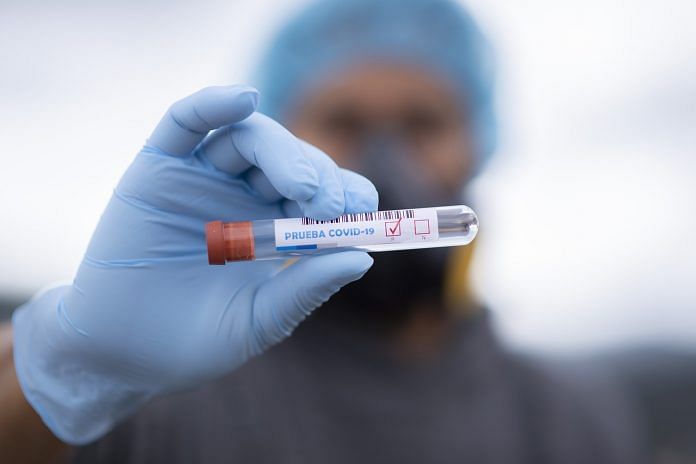New Delhi: Scientists across the world have been trying to find ways of curbing coronavirus’ spread and identify potential treatments against Covid-19.
Here are some of the latest findings from across the globe on the novel coronavirus.
Flushing toilets create clouds of virus-containing aerosols
Flushing a toilet can create a cloud of virus-containing aerosol droplets that lasts long enough for others to breathe in, according to researchers who used computer simulations for their study. It has raised the possibility of Covid-19 transmission with the use of toilets.
Recent studies have shown that SARS-CoV-2 can survive in the human digestive tract and show up in feces of infected people.
In a study published in the journal Physics of Fluids, computer models were used to simulate water and air flows in a flushing toilet and the resulting droplet cloud.
The team found that as water pours into the toilet bowl from one side, it strikes the opposite end, creating vortices or tiny whirlpools.
These vortices continue upward into the air, carrying droplets to a height of nearly 3 feet, where they might settle onto surfaces or be inhaled, the researchers have said.
The team recommends closing the toilet lid before flushing to decrease aerosol spread.
Also read: Plasma therapy works only when donor has recently recovered from Covid-19, says study
Scientists create nanosponges that ‘soak up’ coronavirus
Scientists have created nanosponges coated with human cell membranes to soak up SARS-CoV-2 and prevent them from infecting cells in laboratory settings.
The SARS-CoV-2 uses its spike protein to bind to two proteins on human cells called ACE2 and CD147. Researchers made a nanoparticle decoy coated with the virus’ natural targets ACE2 and CD147 to lure SARS-CoV-2 away from human cells.
A nano-sized polymer core has been coated with cell membranes from human lung cells to create the nanosponges. When administered onto mice, the nanosponges did not show any short-term toxicity.
The nanosponges also neutralised SARS-CoV-2 and prevented it from infecting cells in a petri dish. The researchers plan to next test the nanosponges in animals before moving on to conduct human clinical trials.
Brain MRI scans show Covid-19 patients have distinct patterns
Scientists have used MRI scans to identify certain ‘abnormal patterns’ in the brains of Covid-19 patients.
There has been growing evidence that the central nervous system (CNS) gets affected with Covid-19 infection, since a number of patients have displayed neurological symptoms. However, the underlying mechanism of how the infection exactly affects CNS is still unknown.
The new study published in the Radiology details neuroimaging findings in patients with severe Covid-19, excluding those who have suffered from strokes.
For the study, 37 patients with Covid-19 infection and neurologic symptoms underwent brain MRI from 23 March to 27 April 2020 in 16 French centers.
Researchers have found a distinct neuroimaging pattern in 76 per cent of the patients included in the study. The most frequent MRI findings included signal abnormalities located in the medial temporal lobe, in 43 per cent patients, and hemorrhagic lesions in 30 per cent.
Three main neuroradiological patterns could be distinguished, and the presence of hemorrhage was associated with worse clinical status, the researchers have said.
Also read: Neurologists identify three stages of brain damage due to Covid-19
Covid-19 spreads easily than SARS, MERS among people living together
A new modelling study has suggested that SARS-CoV-2 spreads more easily among people living together than severe acute respiratory syndrome (SARS) or Middle East respiratory syndrome (MERS).
Published in The Lancet Infectious Diseases, the study is the first of its kind to quantify symptomless transmission.
The analysis, based on contact tracing data from 349 people with Covid-19 and 1,964 of their close contacts in China’s Guangzhou, found that people with coronavirus were at least as infectious before they developed symptoms as during their actual illness.
The study also showed that older people (over the age of 60) were most susceptible to household infection with SARS-CoV-2.
The study reiterates that breaking the chain of transmission within households through timely tracing and quarantine of close contacts, in addition to case finding and isolation, could have a huge impact on reducing the number of Covid-19 cases.
Glowing proteins, thread & a smartphone to detect antibodies
Using a combination of cotton threads, glowing proteins and a smartphone camera, scientists have developed a new system for detecting antibodies within minutes — a test that could potentially help gauge immunity against Covid-19.
While some tests simply detect the presence of an antibody, sometimes doctors want to know how much of these proteins is circulating in the blood. Such quantitative testing currently requires expensive, sophisticated instruments.
The new analytical device relies on light-emitting proteins held on a thread. In the presence of the right antibodies, the color of the light emitted by these proteins change. Using a finger-prick-sized drop of blood from pigs spiked with antibodies against HIV, the team has shown that the device could successfully detect antibody levels within five minutes.
Researchers have said that the test can be further modified to detect Covid-19 antibodies.
Also read: Neurologists identify three stages of brain damage due to Covid-19




Is open defecation more safe?